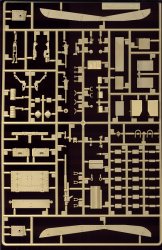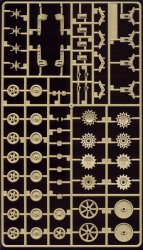Academy 1/35 M3 Stuart 'Honey'
By Michael Benolkin
 |
Background
The M3 was the right tank at the right time. Designed to replace the M2, The M3 light tank was developed not only for the US Army, but also to be deployed under the lend-lease program to allied forces that were already engaged with axis forces around the world. In fact, the M3 began running off the production lines only months before the Japanese attack on Pearl Harbor.
Dubbed 'General Stuart' by the British, the M3 began reinforcing the beleaguered Royal Army forces after their major loss of material the year before during their evacuation at Dunkirk as well as their stretched supply lines supporting operations in North Africa and in the South Pacific. The British liked the Stuart from the start because of its agility. It was 10-20 mph faster than enemy tanks with equivalent armor and firepower. The tank also received the nickname 'Honey' after a buxom entertainer of the time. Nevertheless, a list of modifications was developed for field and depot maintenance to adapt the Stuart the needs and lessons learned by the Royal Army from its extensive and very recent armored combat experience.
It is difficult to believe that this small tank actually carried a crew of four. The commander's cupola was a hexagonal affair attached to the top and rear of the Stuart's small turret. The gunner shared the turret space, whilst the driver and assistant driver/bow gunner occupied the forward hull. Needless to say, these tanks were not air-conditioned and ventilation was only available if you weren't 'buttoned up' for combat. War is hell…
The Stuart was effective in combat in its initial operations, but it didn't take the Germans long to deploy newer tanks with better armor and greater firepower. While the Stuart did receive improvements in armor during its production run, its small turret precluded the installation of larger main guns. One major improvement to the Stuart came in 1942 with the M5 version replacing the M3's gasoline engine with a diesel powerplant. This improved combat survivability, as gasoline would typically explode if the fuel tanks were damaged. The Stuart continued to serve throughout the war, designers turned to the M4 Sherman (and other allied designs) to provide a counter to panzer korps.
The Kit
The Tamiya M3/M5 Stuart kit has been the only option in 1/35 scale for many years. Nicely detailed, the Tamiya kit suffered from a few problems. First and foremost, the turret was inaccurate and not easily corrected. Verlinden would later offer a new turret and detail set for this kit, but it was not a complete solution. Two of the other 'problems' were just typical of most of Tamiya's armor releases in that era - the kit was designed to be motorized. As a result, the lower hull is designed with switch and motor mount holes that need to be plugged, and since the upper and lower hull halves were designed to be separable (to replace batteries), there was no attempt to close the visible gap that allows for a 'see through hull' under the fenders. Lastly, no 1/35 scale tank of that era had anything that resembled interior detailing.
There is a new option for Stuart builders! Academy has released the first of their much-anticipated M3 Stuart series! On looking inside the box, you'll instantly see that it is time to retire that old Tamiya kit. As with all of Academy's recent armor releases, this model is a work of art.
The kit is comprised of five trees of parts molded in tan styrene plastic as well as three additional parts that represent the basic upper hull, lower hull and turret. There are another four trees molded in dark metallic gray that carry the individual track links. Molding is very crisp and there is no flash visible on any of the parts in my example. In addition, you'll notice the variety of bolt heads molded onto the parts tree frames. These can be sliced free and attached onto the appropriate locations on the hull or turret. Nice touch!
The key features of this kit are:
-
Accurate (and enclosed) hull
-
Accurate turret
-
Detailed turret interior (complete with turret basket)
-
Detailed hull interior
-
Detailed suspension
-
Your choice of track links or 'rubber band' tracks
As you can see in the accompanying photographs, Academy has provided a boatload of detail parts for the interior and exterior of this kit. About the only details not in this kit are the inside of the engine compartment and the transmission/differential drive shafts to the drive wheels. In the case of the engine compartment, this is normal for Academy and most people won't pose this tank with its engine hatches open anyway. Those that want an engine compartment will have to wait for the aftermarket folks to catch up. In the case of the drive shafts, the hull interior does provide the hump for the driveline from the engine compartment forward past the driver. The transmission/differential portion ahead of the driver is only partially represented as there is no way to see any of that detail once the hull is assembled anyway.
Markings
 Markings are provided for four Stuarts, with enough extra symbology provided for you to model other units:
Markings are provided for four Stuarts, with enough extra symbology provided for you to model other units:
-
'Bellman' of the 8th King's Royal Irish Hussars, 7th Armoured Division, Libya, May 1941
-
8th King's Royal Irish Hussars, 7th Armoured Division, Libya, November 1941
-
80th Armored Regiment, Armored Force School, Fort Knox Kentucky, 1943
-
3rd Chutai, 7th Sensh Rentai, Manila, Philippines, 1943 (Captured Stuart)





